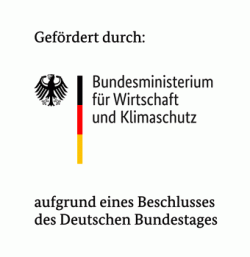Ammonia dual-fuel combustion process in the “AmmoniaMot” project
Description of project
 Maritime transport accounts for about 3% of global energy demand and about 7% of oil consumption. The International Maritime Organization's (IMO) goal of reducing CO2 emissions by 50% by 2050 compared to 2008 can only be achieved through a massive shift to zero-carbon fuels. Ammonia is an important energy carrier for the decarbonization of maritime shipping and is characterized in this context by good framework conditions for production, storage, and infrastructure.
In the AmmoniaMot project, the overall objective of WTZ Roßlau is to develop an ammonia dual-fuel combustion process on a single-cylinder research engine. This goal can be broken down into three individual development goals, which are being worked out in the research network.
The first objective is to gain an in-depth insight into the burning behavior of ammonia (NH3). This will be made possible by a basic literature review, investigations on the single-stroke engine (RCEM) and 3D CFD simulations together with the Technical University of Munich. This knowledge will be used in the design and development of the ammonia dual-fuel injector at Woodward L'Orange and the subsequent single-cylinder studies at WTZ Roßlau. The economic aspects are also highlighted in a benchmark study for ammonia and compared with other renewable energy sources.
The second objective involves setting up an ammonia fuel system on an engine test bench at WTZ Roßlau gGmbH, which will form the basis for the subsequent single-cylinder investigations. The design and construction of the ammonia periphery is a major development focus, taking into account all safety standards, and requires special storage boundary conditions, as well as special requirements for the ammonia handling components. To this end, a fully comprehensive safety concept for the safe handling of ammonia must be developed, appropriate measures derived and implemented.
The third objective involves carrying out basic investigations on the single-cylinder research engine, in which the fundamental boundary conditions of the ammonia dual-fuel combustion process with high-pressure ammonia injection are to be determined. In this process, the combustion process is optimized for defined operating points in terms of engine efficiency, pollutant emissions and combustion stability. The aim of the project is to use the high-performance ammonia dual-fuel combustion process to find an optimum between the energetic ammonia content and engine technology parameters. With regard to exhaust gas components, the focus in this context is on minimizing nitrogen oxide emissions and avoiding ammonia emissions.
Maritime transport accounts for about 3% of global energy demand and about 7% of oil consumption. The International Maritime Organization's (IMO) goal of reducing CO2 emissions by 50% by 2050 compared to 2008 can only be achieved through a massive shift to zero-carbon fuels. Ammonia is an important energy carrier for the decarbonization of maritime shipping and is characterized in this context by good framework conditions for production, storage, and infrastructure.
In the AmmoniaMot project, the overall objective of WTZ Roßlau is to develop an ammonia dual-fuel combustion process on a single-cylinder research engine. This goal can be broken down into three individual development goals, which are being worked out in the research network.
The first objective is to gain an in-depth insight into the burning behavior of ammonia (NH3). This will be made possible by a basic literature review, investigations on the single-stroke engine (RCEM) and 3D CFD simulations together with the Technical University of Munich. This knowledge will be used in the design and development of the ammonia dual-fuel injector at Woodward L'Orange and the subsequent single-cylinder studies at WTZ Roßlau. The economic aspects are also highlighted in a benchmark study for ammonia and compared with other renewable energy sources.
The second objective involves setting up an ammonia fuel system on an engine test bench at WTZ Roßlau gGmbH, which will form the basis for the subsequent single-cylinder investigations. The design and construction of the ammonia periphery is a major development focus, taking into account all safety standards, and requires special storage boundary conditions, as well as special requirements for the ammonia handling components. To this end, a fully comprehensive safety concept for the safe handling of ammonia must be developed, appropriate measures derived and implemented.
The third objective involves carrying out basic investigations on the single-cylinder research engine, in which the fundamental boundary conditions of the ammonia dual-fuel combustion process with high-pressure ammonia injection are to be determined. In this process, the combustion process is optimized for defined operating points in terms of engine efficiency, pollutant emissions and combustion stability. The aim of the project is to use the high-performance ammonia dual-fuel combustion process to find an optimum between the energetic ammonia content and engine technology parameters. With regard to exhaust gas components, the focus in this context is on minimizing nitrogen oxide emissions and avoiding ammonia emissions.
